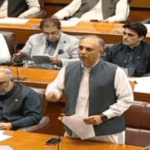ISLAMABAD: Official data shows that while development spending stagnated in the first eight months of the current fiscal year, governments continued to provide funding for lawmakers’ whims.
According to the most recent data on development expenditure given by the Planning Commission, lawmakers spent Rs38 billion of the Rs90 billion budgeted for their initiatives during the last eight months.
With a total spending of only Rs107 billion, the development initiatives under the 34 other federal ministries throughout the 8MFY (July–February) continued to face difficulties.
In eight months, the Public Sector Development Programme (PSDP) spent a total of Rs237 billion, which is approximately Rs13 billion less than the same period the previous year.
Spending on corporations, special regions like Gilgit-Baltistan and Azad Kashmir, and combined districts of the former Federally Administered Tribal Areas were also included in this.
In 8MFY24, legislators receive 42.22 percent of the cash allotted.
With an eight-month financing total of Rs46.6 billion, special territories such as Azad Kashmir, GB, and merged tribal districts received the most amount of funds. The parliamentarians’ plan received Rs37.98 billion.
Approximately 27.4% of the Rs. 170 billion budgeted allotment went toward funding special areas. Meanwhile, of the Rs90 billion allotted, 42.22 percent has already been given to MNA initiatives.
The Sustainable Development Goals Achievement Programme (SAP), which was launched in October 2022 by the Pakistan Democratic Movement (PDM) government, was given an allocation of Rs87 billion. This meant that every one of the coalition’s 174 members of the National Assembly would receive Rs500 million to use for small-scale projects like sewage lines, gas, water, and electricity connections, as well as street repair and upkeep in their respective constituencies.
Before departing office in the second week of August 2023, the same administration increased the finances by Rs3 billion to Rs90 billion for the current fiscal year and approved the release of Rs61 billion.
Only Rs14.4 billion had been used as of August 31. By September 30, the sum had increased to Rs22.9 billion, and by December 31, it had surpassed Rs35 billion, or 39% of the yearly allotment.
The National Economic Council (NEC) and the Special Investment Facilitation Council (SIFC) agreed in January 2024 to set a cap on SAP funding at Rs61 billion, which had already been approved for disbursement, and set aside the remaining Rs30 billion for deficit finance.
The working mechanism
The Planning Division proposed a disbursement mechanism that calls for the development funds allotted in the federal budget to be disbursed at a rate of 20 percent in the first quarter (July-September) and 30 percent in each of the second and third quarters (October-December and January-March, respectively).
The final quarter of the fiscal year (April–June) sees the disbursement of the remaining 20%.
According to this theory, by now at least 70%, or Rs 120 billion, should have been made available for special area development projects.
However, just Rs46.6 billion had been consumed in reality.
Similarly, PSDP projects including roads, dams, and funding for the health, education, and other sectors should have received Rs658 billion of the Rs940 billion that was allocated. However, total spending came to Rs237 billion, or around Rs421 billion less than projected consumption through the end of the 8MFY.
Merely Rs152 billion was allocated towards infrastructure and development, excluding special areas and MNA initiatives.
According to official figures, the eight months’ actual development expenditures of thirty-two ministries and divisions—excluding SAP—amounted to a meager Rs154 billion, compared to their yearly allotment of Rs563 billion.
Against its yearly budget of Rs110.5bn, the water sector spent an additional Rs30.5bn.
The National Highway Authority (NHA) and power firms also spent Rs44.7 billion of their allotted Rs212 billion, despite the fact that these two sectors had seen significant inflows of foreign currency.
Power firms utilized Rs20bn, or around 36% of their Rs55.3bn allotment, while the NHA used Rs25bn, or 16% of its Rs156bn allotment.
Paradoxically, the Ministry of Housing and Works expended Rs8 billion, or around 20% of its Rs41 billion allocation, while the Higher Education Commission could only use Rs14.5 billion, or 24% of its Rs60 billion allotment.
Railways spent roughly Rs18.8bn against its annual allocation of Rs33bn.
According to the data, the government had approved the release of Rs. 508 billion till January 2024; no further funds were made available in February.
36 departments and divisions received Rs372 billion of this, including Rs61.3 billion for MNAs, and NHA and electricity firms received Rs127 billion.
The nation’s underfunded infrastructure development will continue to be hampered for the third year in a row by sharp reductions in even the monies allotted by the parliament.
Massive floods plagued the development program last year. As a result, the development projects would be severely harmed by a lack of finance, which would lower living standards for those who are already experiencing historically high rates of inflation.








